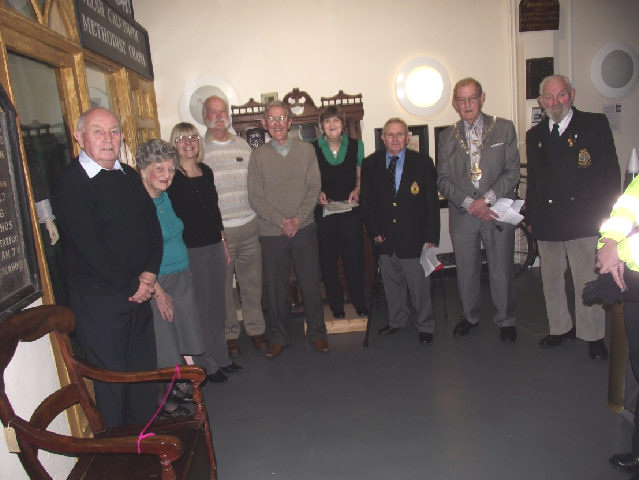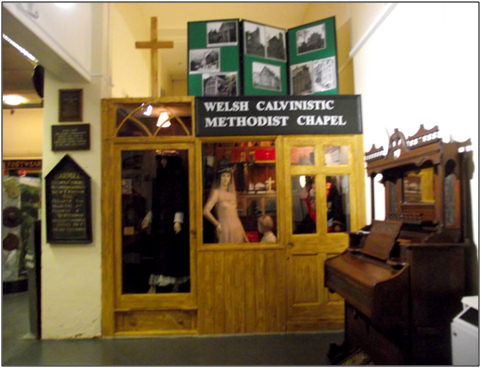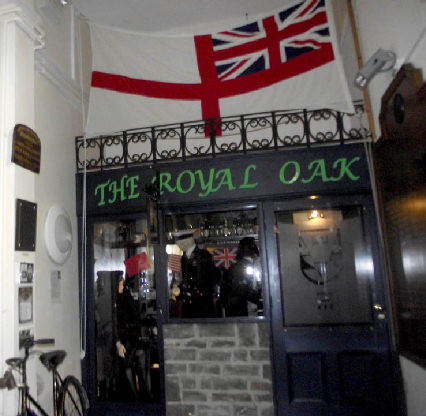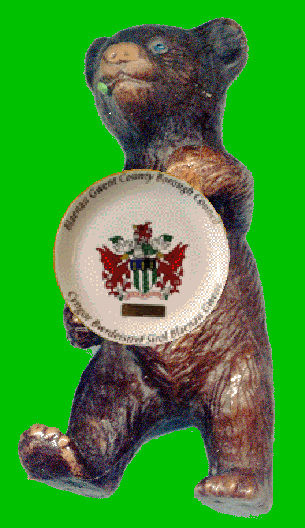New Displays
The Royal Oak and Welsh Chapel displays were officially opened on Saturday 25 th February. If you haven’t already seen them we hope you’ll come along to the Museum for a visit. See page 4 for an account of the opening ceremony.
Thank You
On behalf of the Museum Society I would like to say a big thank you to everyone who contributed in any way to the lovely buffet prepared for the opening of the new displays. I am grateful for the baking of both cakes and savouries, donations of food items and money. Thank you also to the ladies who turned up early Saturday morning to cut sandwiches etc, and to the group who spent most of the morning in the kitchen making tea and coffee and washing up. Thank you all once again.
Peggy Bearcroft
100 Club – February 2012
No. 83 Ann Howells £25
No. 40 Sylvia Pickford £10
No. 18 Margaret Cook £5
Fundraising
January & February – £616
Diary Dates
Wednesday 7th March – ‘The Royal Mint’ by Joseph Payne, 2pm at the Museum
Saturday 24th March – various events in Abertillery celebrating the role of the armed forces
Wednesday 4th April - ‘ The Newport Ship’ by Toby Jones, 2pm at the Museum
Saturday 14th April – coffee morning
The Race to the South Pole
1912 was the year Scott and his party reached the South Pole, only to find that Amundsen had reached the same spot four weeks earlier. It was a bitter blow to Scott although his aim to be first to the Pole was just one of the expedition’s objectives since it was also a scientific expedition and the party continued to collect geological specimens on their difficult return journey – a journey neither Scott nor his four companions would survive.
Cardiff played an important role in supporting the expedition with supplies of free coal and other provisions. The crew were warmly welcomed by the city and the expedition is remembered in various ways even today. Anyone visiting Roath Lake will have seen the little ‘lighthouse’ there – a memorial to the expedition. The city has memorabilia such as the white ensign flown by the Terra Nova, and the ship’s figurehead. These and other artefacts including letters, paintings and photos, can be seen in an exhibition on ‘Scott and the Antarctic’ at the National Museum in Cardiff until early April. It is not a large exhibition but it is well worth visiting. The debate on the decisions taken by Scott will doubtless continue, but the exhibition is helpful in that it makes clear that the fateful expedition was not just about getting to the Pole, but carrying out a wide range of scientific experiments and collecting geological and biological specimens, and meteorological data. The information gathered is still used today.
Books
Many books have been written about Antarctica and those who have explored it, and books have also been published featuring the stunning photographs taken by photographers such as Herbert Ponting and Frank Hurley who accompanied, respectively, the Scott and Shackleton expeditions. You might also enjoy reading the following two books; neither is new, but they are readily available in libraries and bookshops.
“The Birthday Boys” by Beryl Bainbridge was first published in paperback by Penguin in 1993. In this book, a chapter is devoted to each of the men who journeyed to the Pole – Scott himself, Titus Oates, Bill Wilson, Taff Evans and Birdie Bowers – but is written as if an account by the men themselves, each covering a successive period of time on their journey, starting with Taff Evans’ ‘account’ of the celebrations in and departure from Cardiff, and ending with Titus Oates stepping outside the tent to meet his death. Beryl Bainbridge succeeds in giving each man his own distinctive voice and is an emotive account of a harrowing story.
“Tom Crean” by Michael Smith, published in hardback by The Mountaineers Books in 2001. Described as unsung hero, Crean was an integral member of three of the most important expeditions to the Antarctic in the 20 th century, having accompanied both Scott and Shackleton. Crean survived and moved back to his native Ireland where he set up a pub called ‘The South Pole’. The book draws on accounts by various expedition members, including letters written by Crean and it is interesting to read the restrained accounts given by Crean himself of events and privations which now seem unimaginable and which have been graphically described in more modern literature.
Antarctic Exhibitions
Cardiff Museum is just one venue; the exhibition there can be seen until 13 th May 2012. There are exhibitions to be seen around Britain, including:
The Queen’s Gallery, Buckingham Palace
“The Heart of the Great Alone; Scott, Shackleton and Antarctic Photography”. A collection of remarkable photographs by Ponting and Hurley. Until 15 th April 2012.
Swansea Museum – two exhibitions:
“Ninety Degrees South – Edgar Evans, Scott and the Journey to the Pole”. Petty Officer Edgar Evans was perhaps the least well known of the five men on the polar team. He was the first of the five to die, and was a Swansea man.
“Cold Recall: Reflections of a Polar Explorer” – photo exhibit and celebration of Amundsen’s journey to become the first explorer to reach the South Pole. The exhibition features images from lantern slides used by Amundsen in his public lectures and illustrates the challenges of arctic exploration at that time.
Both exhibitions run until 22nd April 2012.
There are many other exhibitions around the country.
If you have a particular aspect of Antarctica you would like to talk about, or a favourite book to recommend, please let us know.
 Congratulations
Congratulations
Congratulations to Bernard and Wendy Hill who celebrated their Golden Wedding on Saturday 3rd March.
I Remember
In the last Newsletter we asked if anyone knew about the pumps in Llanhilleth, and if anyone remembered the dances. Mr Arthur Lewis O.B.E has written with his memories of both.
You were parked in High Street, Llanhilleth. Many pictures are available of this street, one of the best is No. 7 page 10 in Vol 1 by Bill Pritchard. Before the opening of the valley road it was the main road of the western Valley with its shops, Playhouse Cinema, and police station. See also photo 20 page 16. The pumps were for paraffin, and opposite the ironmongery shop of Mr Gore.
My wife Morfydd and I were part of a group of men and women from Blaina, Roseheyworth, Abertillery, Brynithel and Llanhilleth (one name, Morfydd Williams) who danced almost weekly in the Market Hall (Metropole) avoiding the pillars. We would also use the Drill Halls in Abertillery and Llanhilleth, and occasionally the Memo in Newbridge (recently mentioned in BBC Heritage for Heroes). The Rotary Club also held dances in the Working Men’s Institute.
Long Dances
Yes I too remember those dances that carried on until 2.00 a.m. The music was supplied ‘live’ by the Metro Syncopaters Band which consisted of four or five musicians.
Throughout the year there were annual dances organised by the Butcher’s Association, the Rotary Club, the Tennis Club, the Fish Fryer’s Association, the Bon Marche and probably many more which I can’t remember. The main nobs in the town e.g. Lieut. Col. J.J. Lewis, Dr Mulvey and Mr George Jenkins were always dressed in evening suits, and long dresses were the order of the day for the ladies. In the Market Hall those days there was a balcony overlooking the dance floor, where one could go and have a respite from dancing. I think a special licence was had so that alcoholic drinks could be sold as well as soft drinks.
In the Market Hall on ordinary weekdays, dances were held on Tuesdays and Saturdays. No alcoholic drinks were sold and Mr Seybourne used to rubber stamp one’s hand if you wanted to go outside and intended returning to the dance.
They were very well run affairs and I don’t remember any fights or rowdiness. As youngsters we used to think Mr Seybourne a bit of a character, as he always had a cigarette dangling from his mouth but now I am old I think we owe a big thank you to Mr Seybourne for supplying well run entertainment in wartime Britain.
The Roving Reporter
Poetry Please
“Hope” by Theo Carter
On the brow of every man is written,
Whether life by joy or gloom is smitten
Whether to heights of joy he might ascend,
Or to the dark, despondent depths descend
One word to light him through his hardest times
A word which guides him and forever shines,
A word for those who’ve fallen or have sinned,
A word for those whose brightest star is dimmed.
This word, God’s generous gift to man
Of all his glorious gifts alone can span
The gloomiest day and darkest night
Till kindly, cheerful dawn once more breaks bright.
And through the bleakest blackness while we grope
Guides us on. This radiant word is HOPE.
Theo Carter went to Abertillery County School where he was a talented rugby player. He was the grandson of the owners of Ralph’s buses who ran services to Newport and Cwmbran. This was before car ownership was widespread, when bus services were run by local individual operators. furthermore, petrol was rationed in the war and reserved for essential users such as doctors. Theo left Abertillery many years ago to live in Lincoln. He is survived by his wife Marie, and a son Ralph.
Some Welsh Trivia
Did you know?
The world’s first message transmitted by radio in 1897 was made from Lavernock Point to Holm Island – 3 miles away.
Mount Everest was named after the Surveyor General of India who lived in Gwernvale Manor (now a hotel) in Crickhowell.
Monmouth has the only bridge in Britain fortified with a gatehouse, presumably to deter entry into the town.
Britain ’s second largest castle is Caerphilly.
MUSEUM MATTERS
Opening of the new design

“Another triumph for you!” These were the words that greeted Peggy and me as we left the museum on Saturday. It was the opening of the new designs that they were referring to.
The day started with Peggy welcoming and thanking people and organisations that had supported us financially to make this possible. The main funders were Biffaward the Royal Society of Wildlife Trusts, others were GAVO. The Museums Federation, The Welsh Church Fund, Abertillery and Llanhilleth Community Council.
A special welcome was given to the Mayor of Blaenau Gwent, Mike Bartlett, Cllr Nigel Daniels (a member of the Museum for many years and now is on the Management Committee), Cllr John Taylor and his wife Corinne, Nick Landers Regeneration Officer, Frank Olding Heritage Officer, Julian Meek, Abertillery and Llanhilleth Community Council and Graham Bartlett Clerk of the Community Council. I was pleased to see Norma Bartlett who accompanied him also Captains David and Beverley Womersley of the Abertillery Salvation Army and Sharon Norman Community Support Officer and her colleague representing the Police Force, Alan Poore and his wife Christine represented Blaenau Gwent Rugby Football Club.
Peggy then handed over to me and I explained that the main history of the two exhibits was in the information points that people could peruse at their leisure. I went on to tell them how the exhibits came about and the history of the objects on display, starting with the Carmel Chapel moving on to the Royal Oak Pub and ending with story of the pub sign.

Peggy then introduced his Worship the Mayor Mike Bartlett to open the exhibits. Mike mentioned the hard work that our society does and the important part that we play in conserving and telling people of our heritage. At the end of his speech after opening the exhibits he presented me with a plate for the museum with the Coat of Arms of Blaenau Gwent County Borough Council on.
Afterwards a Prayer and a Blessing on the museum and those involved with its work was given by Captain Beverley Womersley. This came as a surprise to her as she had not been told of her part in the proceedings. Beverley is a member of our society and shares my enthusiasm for Egyptology and the history of Egypt.

When the official proceedings were over, it was time for the buffet. It was a sumptuous feast with more than enough for everyone.
Since the event people have commented on how much they enjoyed themselves and of the wonderful atmosphere present in our museum. We always have a good atmosphere at our events but I have to say last  Saturdays was particularly potent.
Saturdays was particularly potent.
On a personal note as I have not been well for a few weeks I was amazed at the number of people who came to me saying how good it was to see me back to my old self. It made me feel humble that so many people cared. It proved once again that our society is a family bound together by a single bond: The love for our museum.
Don Bearcroft Curator.
